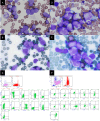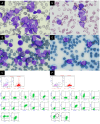The Emergence of Subclones Following Initial Chemotherapy in Mixed Phenotype Acute Leukemia
- PMID: 40755566
- PMCID: PMC12316484
- DOI: 10.7759/cureus.87163
The Emergence of Subclones Following Initial Chemotherapy in Mixed Phenotype Acute Leukemia
Abstract
Mixed phenotype acute leukemia (MPAL) is a rare subtype of acute leukemias, and it is characterized by the immunophenotypic expression of multiple hematopoietic lineages and the potential for lineage switching post-treatment. Diagnosing MPAL can be challenging, particularly in cases with small immunophenotypically distinct subclones or subpopulations exhibiting weak antigen expression. We present two cases of MPAL where subclones or lineage switches emerged following initial treatment. Both cases exhibited a myeloperoxidase (MPO)-positive population of leukemic cells, which was initially either undervalued or overestimated, complicating their diagnosis. In one case, leukemic blasts tested negative for MPO in immunohistochemical (IHC) staining; however, flow cytometric analysis revealed a minor subclone that was weakly positive for MPO. In the other patient, leukemic blasts tested positive for MPO through IHC staining. The latter patient was diagnosed with acute myelogenous leukemia; however, the leukemic cells exhibited lymphoblastic morphological features and co-expressed both myeloid and lymphoblastic antigens in each case. Following initial treatments, selective pressure causes the proliferation of leukemic cells resistant to chemotherapy, with an immunophenotypic shift in the blasts, requiring treatment modification in both cases. These two cases highlight the diagnostic and therapeutic complexities of MPAL and underscore the crucial role of comprehensive immunophenotyping in identifying minor subclones, thereby ensuring an accurate diagnosis, informing treatment selection, and facilitating timely therapeutic adjustments.
Keywords: allogeneic hematopoietic stem cell transplantation; lineage switches; lineage-matched therapy; mixed-phenotype acute leukemia; molecular residual disease; myeloperoxidase; subclones.
Copyright © 2025, Murao et al.
Conflict of interest statement
Human subjects: Informed consent for treatment and open access publication was obtained or waived by all participants in this study. Conflicts of interest: In compliance with the ICMJE uniform disclosure form, all authors declare the following: Payment/services info: All authors have declared that no financial support was received from any organization for the submitted work. Financial relationships: Junya Kuroda declare(s) personal fees from Janssen Pharmaceutical. Junya Kuroda declare(s) personal fees from Abbvie. Junya Kuroda declare(s) personal fees from Pfizer. Junya Kuroda declare(s) personal fees from BeiGene. Junya Kuroda declare(s) personal fees from Bristol-Myers Squibb. Junya Kuroda declare(s) research funding from Kyowa Kirin. Junya Kuroda declare(s) research funding from Chugai Pharmaceutical. Junya Kuroda declare(s) research funding from Japan Blood Product Organization. Junya Kuroda declare(s) research funding from Sumitomo Pharmaceutical. Junya Kuroda declare(s) research funding from Otsuka Pharmaceutical. Junya Kuroda declare(s) research funding from Asahikasei. Junya Kuroda declare(s) research funding from Mochida Pharmaceutical. Junya Kuroda declare(s) personal fees from Kyowa Kirin. Junya Kuroda declare(s) personal fees from Chugai Pharmaceutical. Junya Kuroda declare(s) personal fees from Ono Pharmaceutical. Junya Kuroda declare(s) personal fees from Sanofi. Junya Kuroda declare(s) personal fees from Novartis. Junya Kuroda declare(s) personal fees from Pfizer. Junya Kuroda declare(s) personal fees from Astellas Pharmaceutical. Other relationships: All authors have declared that there are no other relationships or activities that could appear to have influenced the submitted work.
Figures


Similar articles
-
PAX5 as a diagnostic tool in unconventional acute leukemia: Establishing immunohistochemical evidence of B-cell lineage.Hum Pathol. 2025 Sep;163:105903. doi: 10.1016/j.humpath.2025.105903. Epub 2025 Aug 7. Hum Pathol. 2025. PMID: 40782987
-
Chemotherapy-free treatment of B-lymphoid/myeloid mixed phenotype acute leukemia: two case reports and literature review.Immunotherapy. 2025 Jun;17(9):639-647. doi: 10.1080/1750743X.2025.2527018. Epub 2025 Jul 13. Immunotherapy. 2025. PMID: 40653706 Free PMC article. Review.
-
A systematic overview of chemotherapy effects in acute myeloid leukaemia.Acta Oncol. 2001;40(2-3):231-52. doi: 10.1080/02841860151116321. Acta Oncol. 2001. PMID: 11441935
-
[Volume and health outcomes: evidence from systematic reviews and from evaluation of Italian hospital data].Epidemiol Prev. 2013 Mar-Jun;37(2-3 Suppl 2):1-100. Epidemiol Prev. 2013. PMID: 23851286 Italian.
-
Signs and symptoms to determine if a patient presenting in primary care or hospital outpatient settings has COVID-19.Cochrane Database Syst Rev. 2022 May 20;5(5):CD013665. doi: 10.1002/14651858.CD013665.pub3. Cochrane Database Syst Rev. 2022. PMID: 35593186 Free PMC article.
References
-
- High-dose methotrexate therapy significantly improved survival of adult acute lymphoblastic leukemia: a phase III study by JALSG. Sakura T, Hayakawa F, Sugiura I, et al. Leukemia. 2018;32:626–632. - PubMed
-
- Mixed-phenotype acute leukemia: historical overview and a new definition. Weinberg OK, Arber DA. Leukemia. 2010;24:1844–1851. - PubMed
Publication types
LinkOut - more resources
Full Text Sources
Research Materials
Miscellaneous
